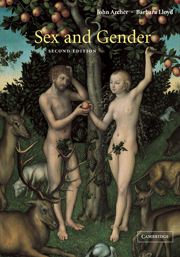Book contents
- Frontmatter
- Contents
- List of figures
- List of tables
- Preface
- 1 Commonsense beliefs and psychological research strategies
- 2 Stereotypes, attitudes, and personal attributes
- 3 Origins
- 4 Developmental influences
- 5 Sexuality: psychophysiology, psychoanalysis, and social construction
- 6 Aggression, violence, and power
- 7 Fear, anxiety, and mental health
- 8 The domestic sphere
- 9 Work, education, and occupational achievement
- 10 Looking back and looking ahead
- References
- Index
5 - Sexuality: psychophysiology, psychoanalysis, and social construction
Published online by Cambridge University Press: 11 May 2012
- Frontmatter
- Contents
- List of figures
- List of tables
- Preface
- 1 Commonsense beliefs and psychological research strategies
- 2 Stereotypes, attitudes, and personal attributes
- 3 Origins
- 4 Developmental influences
- 5 Sexuality: psychophysiology, psychoanalysis, and social construction
- 6 Aggression, violence, and power
- 7 Fear, anxiety, and mental health
- 8 The domestic sphere
- 9 Work, education, and occupational achievement
- 10 Looking back and looking ahead
- References
- Index
Summary
Introduction
We began our detailed examination of reproduction in chapter 3 by asking how and why sex evolved. In this chapter we explore human sexuality from three different perspectives: those of psychophysiology, psychoanalysis, and history–sociology.
Using the term psychophysiology, we review the classic studies of Masters and Johnson and of Kinsey. Their research provides antiseptic, empirical descriptions of adult sexual behaviour and offers answers to questions such as ‘What are the measurable physiological correlates of orgasm?’ and ‘In what circumstances do people find sexual satisfaction?’
In examining the psychoanalytic approach, we move from the readily observable world of physiological function and conscious experience to explore the meaning of sexual experience in our inner worlds. Here we seek answers to different sorts of questions and pursue the origins of adult sexual satisfaction in early childhood experiences. We ask how the child's recognition of anatomical sex differences influences adult personality and how erotic excitement serves social life.
In the final section we consider the social construction of the concepts of sex, gender, and sexuality, and the influence of social values on the creation of gender roles and identities. Historical research suggests that our current binary representation of gender only emerged in the late eighteenth century (Laqueur, 1990). First we examine the classical, hierarchical view of sex and then consider critiques of binary roles, heterosexuality, and homosexuality. From these analyses we gain a perspective on our own society's definitions of the roles of men and women, and explore the limitations of framing sexuality in terms of reproductive success.
- Type
- Chapter
- Information
- Sex and Gender , pp. 84 - 108Publisher: Cambridge University PressPrint publication year: 2002



